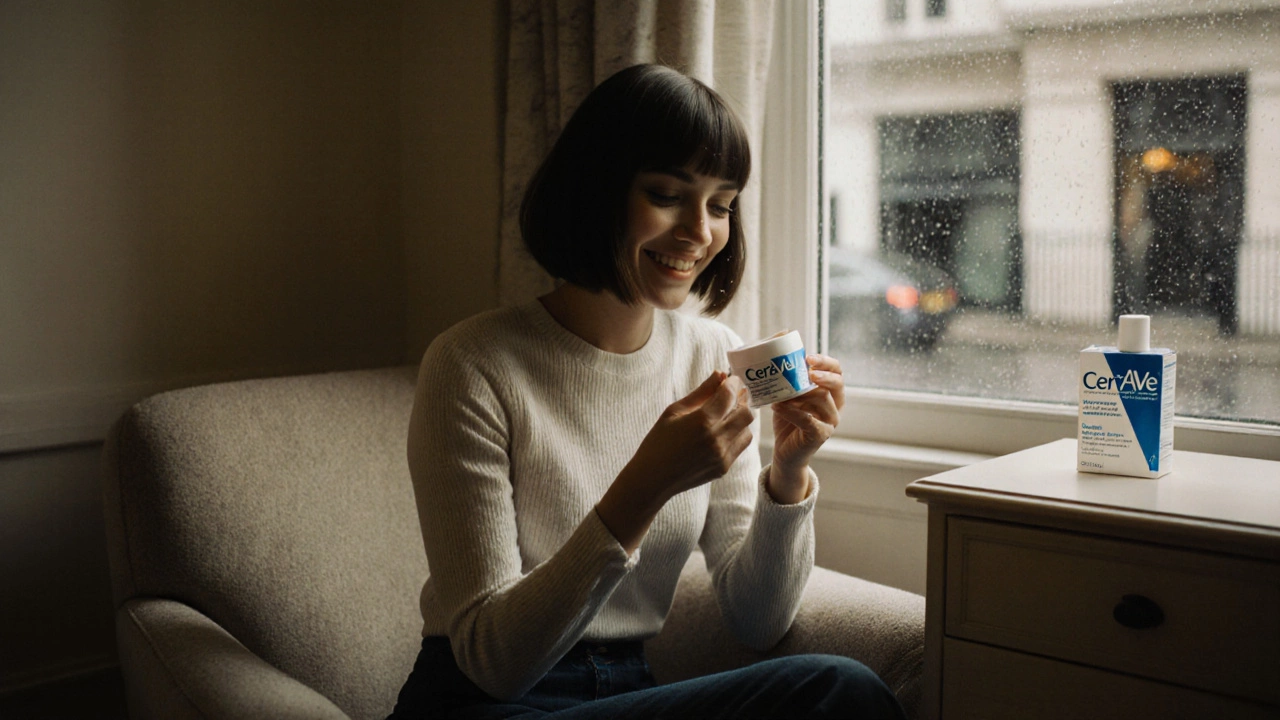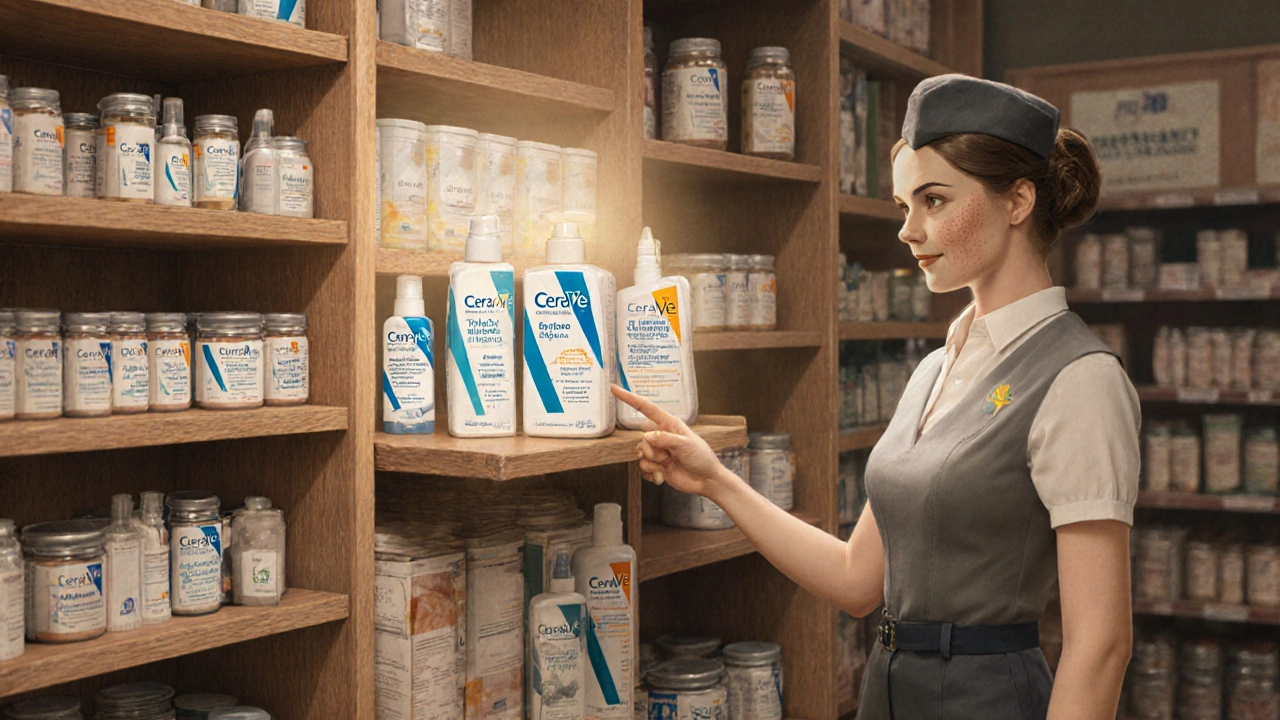CeraVe Product Selector
Select Your Skin Type
Select Your Primary Concern
Your Recommended Product
CeraVe is a skincare brand launched in 2005 by a team of dermatologists and later acquired by L'Oréal. Its claim to fame is a formula that mimics the skin’s natural barrier, thanks to a mix of ceramides, hyaluronic acid, and a patented MVE (Multivesicular Emulsion) delivery system. This combination delivers lasting hydration without feeling greasy, which explains the surge in CeraVe popularity across age groups and skin types.
Key Ingredients That Set CeraVe Apart
At the heart of every CeraVe product are three essential components:
- Ceramides are lipid molecules that act like mortar between skin bricks, sealing moisture and defending against irritants. CeraVe incorporates three types - ceramide NP, ceramide AP, and ceramide EOP - mirroring the skin’s own composition.
- Hyaluronic Acid is a humectant that can hold up to 1,000 times its weight in water, pulling hydration from the environment into the epidermis.
- MVE Delivery System (Multivesicular Emulsion) slowly releases actives over 24‑48hours, ensuring consistent moisturisation and reducing the need for frequent re‑application.
Together they create a formula that not only moisturises but also repairs the skin barrier - a claim backed by multiple clinical trials.
Science‑Backed Benefits for Real‑World Skin Problems
Research published in the *Journal of Dermatological Science* (2022) showed that subjects using a ceramide‑rich moisturizer experienced a 30% increase in barrier recovery after tape‑strip damage, compared with a standard moisturizer. The same study highlighted hyaluronic acid’s role in plumping fine lines, while MVE’s controlled release lowered transepidermal water loss by 18% after 48hours.
Because the formula is non‑comedogenic and fragrance‑free, it suits:
- Acne‑prone teenagers seeking a lightweight hydrate without clogging pores.
- Adults with eczema who need barrier support without irritating additives.
- Older skin that craves both moisture and anti‑aging benefits.
Dermatologist Endorsement and Clinical Trust
When a product is co‑developed by board‑certified dermatologists, it gains instant credibility. CeraVe’s advisory panel includes Dr. Anjali Patel (American Academy of Dermatology) and Dr. Mark Lee (International Society of Dermatology). Their input ensures that every new launch is tested for:
- Allergy potential (patch‑testing on 500+ volunteers).
- pH balance (maintained at a skin‑friendly 5.5).
- Stability of ceramides over a 24‑month shelf life.
These rigorous standards are rarely matched by mass‑market rivals, giving CeraVe a reputation as “the dermatologist’s favorite drugstore brand.”

Affordability and Wide Distribution
Despite its premium‑grade ingredients, CeraVe prices between $8 and $15 for most sizes, positioning it firmly in the drugstore tier. Its presence in pharmacies, grocery chains, and online retailers in over 70 countries makes it easy to pick up on a grocery run or order with a click. This balance of quality and price fuels repeat purchases - a 2024 Nielsen survey found that 62% of regular users buy CeraVe at least once a month.
How CeraVe Stacks Up Against Other Drugstore Brands
| Brand | Key Ingredient | Price (30ml) | Dermatologist Recommended? | Non‑comedogenic |
|---|---|---|---|---|
| CeraVe | Ceramides + Hyaluronic Acid | $12 | Yes | Yes |
| Cetaphil | Glycerin | $10 | Yes (minor) | Yes |
| Neutrogena | Niacinamide | $14 | Occasionally | Mixed |
The table highlights three takeaways:
- CeraVe uniquely blends ceramides with hyaluronic acid, delivering both barrier repair and deep hydration.
- Its price sits comfortably between Cetaphil’s budget‑friendly option and Neutrogena’s slightly higher cost.
- Consistent dermatologist endorsement gives it an edge in clinical trust.
Real‑World Use Cases: From Acne to Eczema
Because the brand offers a range of formulations - Foaming Cleanser, Moisturizing Cream, Daily Moisturizing Lotion, and Healing Ointment - users can build a routine that targets specific concerns.
- Acne: The Foaming Cleanser contains 0.5% salicylic acid and is oil‑free, making it ideal for oily, breakout‑prone skin. Follow with the Daily Moisturizing Lotion for light‑weight hydration.
- Eczema: The Healing Ointment packs a higher concentration of ceramides and petrolatum, creating an occlusive barrier that soothes flare‑ups overnight.
- Anti‑aging: The Cream contains niacinamide and peptides, which work alongside ceramides to improve texture and reduce fine lines.
Testimonials from South African users in Durban report that a simple morning‑evening routine of cleanser + lotion reduces dryness during winter months by up to 45%.
Choosing the Right CeraVe Product for Your Skin
Not every CeraVe product suits every skin type. Here’s a quick decision guide:
- Identify your primary concern: dryness, acne, sensitivity, or signs of aging.
- Match the formulation:
- Dry or eczema‑prone: Moisturizing Cream or Healing Ointment.
- Oily or acne‑prone: Foaming Cleanser + Daily Moisturizing Lotion.
- Combination/normal: Lotion (lighter texture) with optional serum.
- Consider texture preference: cream (rich), lotion (light), ointment (very occlusive).
- Check for additives: If fragrance is a trigger, stick to the “Fragrance‑Free” line.
By following these steps, you’ll avoid the common mistake of buying a product that feels nice but doesn’t address the underlying barrier deficiency.

Frequently Asked Questions
What makes CeraVe different from other drugstore moisturizers?
CeraVe’s formula uniquely combines three skin‑identical ceramides, hyaluronic acid, and the MVE delivery system. This trio repairs the skin barrier, locks in moisture for up to 48hours, and remains non‑comedogenic, which most generic moisturizers lack.
Is CeraVe suitable for sensitive skin?
Yes. All core CeraVe products are fragrance‑free, paraben‑free, and formulated with a balanced pH of 5.5. Dermatologists specifically recommend them for eczema‑prone and rosacea‑sensitive skin.
Can I use CeraVe’s moisturizer under makeup?
Absolutely. The lightweight Daily Moisturizing Lotion absorbs in under a minute, leaving a smooth base that doesn’t cause product‑pilling. Many makeup artists recommend it as a primer for oily skin.
How often should I apply CeraVe products?
For most skin types, a morning and evening routine works best: cleanse, then apply the appropriate moisturizer while skin is still damp. The MVE system continues to release actives, so re‑application isn’t necessary throughout the day.
Is CeraVe safe for children?
Yes. The brand offers a Kids’ line that uses the same ceramide blend without harsh surfactants. Pediatric dermatologists often prescribe it for infants with atopic dermatitis.
Where can I buy authentic CeraVe products?
Authentic CeraVe is available at major pharmacy chains, supermarkets, and reputable online retailers like Amazon, Boots, and the official CeraVe website. Avoid third‑party sellers with unusually low prices to prevent counterfeit products.
Does CeraVe contain any harmful chemicals?
No. CeraVe’s formulations are free from parabens, sulfates, fragrance, and dyes. The only exception is the Healing Ointment, which adds a small amount of petrolatum - a safe, occlusive ingredient used in many medical moisturizers.
